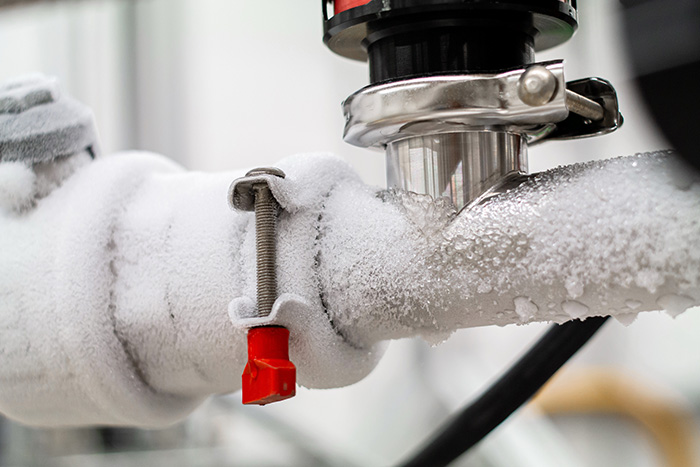How to Prevent Frozen Pipes in Cold Weather: Pro Tips
How to Prevent Frozen Pipes in Cold Weather: Pro Tips
Blog Article
What are your opinions about How to Prevent Your Pipes From Freezing?

Cold weather can damage your pipes, particularly by freezing pipes. Right here's just how to prevent it from happening and what to do if it does.
Intro
As temperatures decline, the risk of frozen pipelines boosts, possibly leading to pricey fixings and water damage. Understanding exactly how to prevent icy pipes is important for house owners in chilly climates.
Prevention Tips
Shielding susceptible pipes
Cover pipes in insulation sleeves or utilize heat tape to secure them from freezing temperatures. Concentrate on pipelines in unheated or outside areas of the home.
Home heating methods
Maintain interior rooms adequately heated up, especially areas with pipes. Open cabinet doors to enable warm air to distribute around pipelines under sinks.
Exactly how to identify frozen pipelines
Look for decreased water flow from faucets, unusual smells or sounds from pipes, and visible frost on exposed pipes.
Long-Term Solutions
Architectural changes
Think about rerouting pipelines far from outside walls or unheated areas. Add extra insulation to attics, basements, and crawl spaces.
Upgrading insulation
Buy premium insulation for pipes, attics, and walls. Proper insulation aids maintain constant temperatures and decreases the risk of icy pipes.
Safeguarding Outdoor Plumbing
Yard pipes and outside faucets
Disconnect and drain pipes yard tubes prior to winter months. Set up frost-proof spigots or cover outdoor taps with protected caps.
Comprehending Icy Pipelines
What triggers pipelines to ice up?
Pipes ice up when subjected to temperature levels listed below 32 ° F (0 ° C) for expanded periods. As water inside the pipelines ices up, it broadens, putting pressure on the pipe wall surfaces and potentially triggering them to break.
Threats and problems
Icy pipelines can cause water supply interruptions, residential property damage, and costly repair services. Burst pipelines can flooding homes and cause considerable structural damages.
Indications of Frozen Water Lines
Recognizing icy pipelines early can stop them from breaking.
What to Do If Your Pipelines Freeze
Immediate activities to take
If you suspect icy pipelines, maintain faucets available to soothe stress as the ice thaws. Make use of a hairdryer or towels taken in hot water to thaw pipes slowly.
Conclusion
Preventing frozen pipes requires proactive measures and fast feedbacks. By recognizing the causes, indicators, and safety nets, house owners can secure their plumbing during winter.
6 Proven Ways to Prevent Frozen Pipes and Protect Your Home
Disconnect and Drain Garden Hoses
Before winter arrives, start by disconnecting your garden hoses and draining any remaining water. Close the shut-off valves that supply outdoor hose bibs and leave the outdoor faucet open to allow any residual water to drain. For extra protection, consider using faucet covers throughout the colder months. It’s also important to drain water from any sprinkler supply lines following the manufacturer’s directions.
Insulate Exposed Pipes
Insulating your pipes is an effective way to prevent freezing. Pipe insulation is readily available at home improvement stores and is relatively inexpensive. Pay close attention to pipes in unheated areas such as the attic, basement, crawl spaces, or garage. Apply foam insulation generously to create a buffer against the cold. You can also wrap your pipes in heat tape or thermostat-controlled heat cables for added warmth.
Seal Air Leaks
Inspect your home for any cracks or openings that could let in cold air. Seal any holes around the piping in interior or exterior walls, as well as the sill plates where your home rests on its foundation. Additionally, make sure to keep your garage door closed unless you’re entering or exiting. Leaving it open creates a significant air leak that can lead to frozen pipes.
Allow Warm Air Circulation
During cold snaps, it’s essential to allow warm air to circulate evenly throughout your home. Leave interior doors ajar to promote better airflow. Open kitchen and bathroom cabinets to help distribute heat consistently around the rooms. If you have small children or pets, be sure to remove any household chemicals or potentially harmful cleaners from open cabinets for safety.
Let Faucets Drip
A small trickle of water can make a big difference in preventing ice formation inside your pipes. When temperatures drop significantly, start a drip of water from all faucets served by exposed pipes. This continuous flow helps prevent the water from freezing. Additionally, running a few faucets slightly can relieve pressure inside the pipes, reducing the chances of a rupture if the water inside does freeze.
https://choateshvac.com/6-proven-ways-to-prevent-frozen-pipes-and-protect-your-home/

Do you really like more info about 6 Ways to Prevent Frozen Pipes? Try leaving a remark directly below. We'd be glad to listen to your opinion about this review. We hope that you visit us again before long. Kindly set aside a second to distribute this page if you liked it. Thanks a bunch for being here. Come back soon.
Or Book Technician Here Report this page